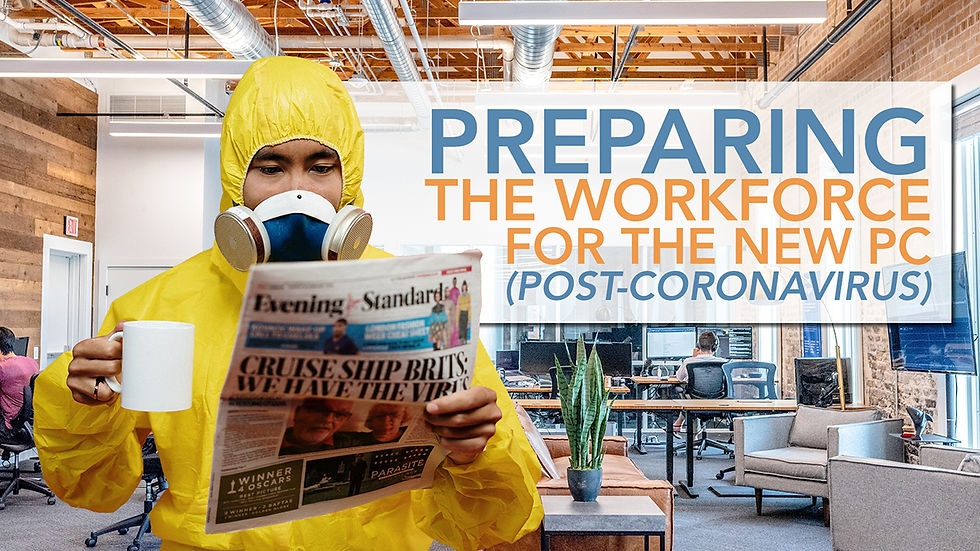Preparing the Workforce for the New PC: Post-Coronavirus
- May 27, 2020
- 4 min read
Updated: Mar 4, 2021

03/04/2021 - As vaccinations become commonplace and restrictions begin to lift, more employers will begin to open their offices to a returning workforce. Whether it happened last summer, or you are just starting to reopen, the three principles of adapt, communicate and prepare still hold true.
Whether or not your workplace has reopened, never shut down, or continues to run with a skeleton crew, all employers need to prepare for the new PC – the post coronavirus workplace.
While some are calling this the new normal – I don’t like it. I don’t like having change forced upon me. I don’t like having to do new things. I don’t like the phrase “new normal.” Alas, we have no choice. Since change is never-ending and new challenges will always present themselves, we need to move forward and prepare for our “next normal.”
Employers, business owners and human resource professionals should not only focus on the current return-to-work situation, but also look long-term and develop an ongoing change management culture. We will tackle that topic in another post, but for now, the focus at work will remain on the current situation and creating the new PC by adapting, communicating and preparing.
Adapt

Start with the health and safety of your employees and the workplace. Employee and visitor screening, new cleaning and disinfecting procedures and physical workplace distancing are all changes that can and should happen first. Employees want to know their workplace is safe and, in fact, OSHA requires employers to provide a workplace free from recognized hazards that could cause death or serious physical harm. These changes, while quite impactful, can be implemented with relative ease and swiftness.
PTO, telework and travel policies should also be adapted to fit this next normal. Many employees are worried about running out of PTO if they get sick or want to have some vacation time later in the year, but the opposite could also become a problem. Employees who haven’t used their PTO because of the addition of Emergency Paid Sick Leave, or a furlough that precluded them from using PTO, may have extra time available at the end of the year. Rollover balances and negative balances are changes employers may need to consider on a temporary or permanent basis.
Companies may also have to adapt their work schedules to allow for staggered start times and occasional telework options. Staggered start times help with overcrowding the entrance if your company is screening all employees. Additionally, crowded elevators and breakrooms can be eased by adjusting work schedules. Finally, training, conferences and business travel may need to be adjusted to take into consideration social distancing and worker safety. I am not advocating removing these events, but rather rethinking how to accomplish the same goal. I am a big advocate of face time and in-person training and conferences, and firmly believe we can continue these meetings. In some cases, we just need to be a little more creative.
Communicate

Going back to employee health and safety – not only do they need to be safe, they need to feel safe. Many of the current issues revolve around the emotional wellbeing of employees. Fear of the unknown is a genuine concern. By communicating the efforts and new practices of the employer, employees will have a greater understanding of what is being done to protect them.
Additionally, any policy changes including PTO, work-from-home and travel need to be communicated to employees. This is best done through a dialogue, not just a memo emailed to everyone. Communication should not be a one-way street. Instead, seeking feedback and understanding is critical to a company successfully adapting to the next normal.
Many managers and leaders may be well equipped to handle change personally, but implementing it throughout the organization is often the downfall of an otherwise high performing company. Change management and effective implementation will go a long way in helping companies find each next normal coming down the road. Leadership training will also help leaders define and communicate the changing expectations of our workplace. Employees need to know what is expected of them to succeed – and without information – they will fill the vacuum, often with misinformation.
Prepare

Companies that believe returning back to work means COVID-19 is in the past may be in store for a rude awakening. Anyone who tells you with any certainty what is going to happen with this virus is most likely wrong. The best experts in the world have changed or even reversed course several times in just four months. Prognosticators who said we would only have minimal impacts, and those who said millions would succumb to the virus by June were both wrong. So how do you prepare for the unknown? By preparing for the worst but hoping for the best.
Business continuity planning is essential. Whether it’s “COVID-19: The Return”, or a regional outbreak, companies need to plan now for the steps they will take to insulate their organizations against the financial devastation seen by some over the past few months. Whether it is an outbreak among employees in your organization, or a city or state-wide mandated shutdown, how will you continue to move forward? Companies lucky enough to have received Paycheck Protection Program funding should not expect the government to continue to step in and help.
Instead, organizational leaders need to continue to adapt their policies, revisit the distribution of their products and services, and find new ways to conduct business in this ever-changing environment. COVID-19 might not come back in the fall, and we may not see business interruptions for months or years, but are you willing to make that bet? How easy was it for the government to shut down our economy? Who’s to say the next worldwide pandemic, or regional virus outbreak, won’t elicit the same response?
Companies need to be prepared in order to survive and need to implement their strategy extremely well in order to thrive. This takes time, money, resources, and planning. Are you ready for the next normal? Are you ready for the new PC?






Comments